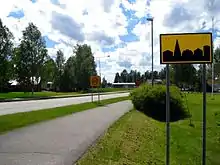Urban areas in Finland
An urban area in Finland is defined as an inhabited area of at least 200 people and a maximum distance of 200 metres (660 ft) between buildings.[1][2] The Finnish term for this is a taajama (Swedish: tätort). Because of the strict definition of a taajama, these areas exist both inside and outside of city and municipal borders.

The statistical definition is shared with other urban areas in the Nordic countries.
The largest taajama in Finland is the Helsingin keskustaajama ("Helsinki central urban area") with approximately 1,200,000 inhabitants in 2014. It extends across Helsinki as well as 10 other municipalities in the Greater Helsinki area. The second largest is the Tampereen keskustaajama with almost 320,000 inhabitants in 2012.
The presence of taajama areas is used to regulate traffic, with a default of 50 kilometres per hour (31 mph) speed limit inside a taajama and 80 kilometres per hour (50 mph) outside. Each major road leading in or out of a taajama is marked with a road sign.
See also
References
- "Taajamissa asuu 84 prosenttia väestöstä". Statistics Finland (in Finnish). 15 January 2008. Retrieved 20 February 2017.
- Facta (encyclopedia) part 16, page 203, finnish

